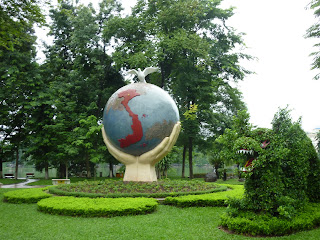I spent the last five days visiting World Vision projects in rural areas of Myanmar and was amazed at the warmth and hospitality with which we were received in each of the villages we visited. The goal of the trip was to meet with the Area Development Project (ADP) teams providing support to these villages to better understand their work environments, challenges, successes, and ways to best support them. From the capital city of Yangon we took a 1 hour flight to Bagan, then a two hour drive to the ADP office. The villages we visited were yet another 2 1/2 hours away in very remote areas and we needed special visas, 4-wheel drive, and government accompaniment to visit – this created long days but we were rewarded with rich experiences and the opportunity to see and hear in person testimonies of improved health and well-being as a result of several projects that are under way in the villages. The WV facilitated projects include:
Food and Water Security: Providing landscape and conservation principles for water security in dry and drought areas. Sharing best practices in food (agriculture and livestock) production and sustainability
 |
| This region is very dry and sandy |
 |
| Water source for Ohk Hla Village |
 |
| The pond, a primary water source will be dry before the next rains |
Health and Nutrition: Providing instruction on nutrition and maternal health principles such as healthy diet during pregnancy, exclusive breast feeding, and pre-natal and post-natal care. One woman shared that her older children get sick more often than the younger children who benefited from the health training and practices. The younger children maintain healthier weight (more weight), do better in school, and are overall healthier. HIV/AIDS awareness, and reproductive health and family planning are also saving lives and fewer deaths related to child delivery are occurring.
 |
| Nutrition Groups - Growth, Energy, and Wellness with Rice in the center |
Early Childhood Development: Early childhood development programs help prepare children for school and provide important life skills related to nutrition, behavior, and learning.
Savings and Loan: Two of the villages we visited had established a savings and loan program amongst themselves. Each month the participants meet to make deposits into the common fund. Pass books are maintained and interest is accrued. Loans are available from the common fund as well, at a low interest rate. The implementation of programs like these helps remove dependence on high interest money lenders and provides long term stability to the people of the village.
 |
| Savings and Loan group meeting |
 |
| Silk Weaving |
Hospital: A hospital is under construction that is being 100% funded by the people in the village. They receive official support through well priced materials and will also receive official support through staffing of doctors and nurses once the facility is completed. This is not a World Vision project.
 |
| Hospital Construction |
 |
| Reviewing the hospital construction plans - the hospital is community funded. The govt. will provide medical staff. |
Reforestation: WV helped provide training on growing techniques that help conserve water. The nursery we visited had several thousand plants and trees planted in small plastic bags and meticulously cared for by people in the village. After 6 months the saplings will be sold for reforestation purposes. This provides ongoing financial and environmental support. I learned that 7 eucalyptus trees grown for 7 years produce enough wood to build one house. The nursery and reforestation project provide long-term sustainability for the village and the surrounding land.
 |
| Reforestation planting using water conserving bags for planting |
My heart goes out in gratitude to all of the people we met and for the warmth and loving communal experience they live and shared. I am very happy to see the WV projects having a significant and measurable favorable impact to health and economic sustainability, and also pray the way of life I observed will be preserved as there was much joy and strong sense of community displayed throughout our trip.
Other notes: The chalk you see on kids and some adults faces is called Thanaka and is a sunscreen worn nearly all the time by children and women. It is made form the ground bark of the sandalwood tree. The traditional and standard dress for men and women is long sarong-like wraps of silk, cotton, or silk-cotton blend, called a longyi. Despite being in an extremely dry and dusty region of Myanmar the villages are exceptionally clean and orderly. Work duties are shared between families and between men and women. The drought like conditions create water and food security issues, which have been aided greatly by the improvements to water retention at the main water pond, improved technologies for growing, and increased health and yield from livestock. In the villages we visited the main sources of livelihood were agriculture, weaving, and casual labor.
Additional Photos:
 |
| Temples in Bagan with hot air balloons in the background |
 |
| Temple in Bagan |
 |
| Village near Chauk |
 |
| Community Planning |
 |
| WV facilitation of a community planning session scheduling for a full calendar year |
 |
| Community planning participants |
 |
| Mother and Child |
 |
| Common carts in the villages |
 |
| Knife sharpenin |
 |
| ADP Manager Kai Kai |
 |
| Plums drying |
 |
| Silk weaving |
 |
| Drying out husks for next years silk production |
 |
| Saying farewell |
 |
| Bamboo fence construction |
 |
| WV People and Culture Team in Yangon |
 |
| Chauk ADP Team |
 |
| Yenan Chaung ADP Manager Saw Marksu |
 |
| Members of the Yenan Chaung ADP |


















































